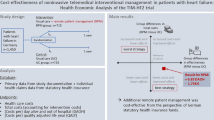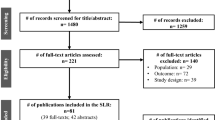Abstract
Cardiovascular disease is one of the major causes of mortality in the world, with high human and financial burdens on communities. Telemedicine is a tool for providing services for patients that are difficult to access or in need of immediate care. The aim of this study was to systematically review economic evaluation studies that compared telemedicine with usual care for cardiovascular patients. A systematic review was conducted according to Preferred Reporting Items for Systematic Reviews and Meta-Analyses guidelines and related articles published up to December 2018 were searched in different databases (PubMed, Embase, SCOPUS, Global Health, Google Scholar, Magiran, SID). The articles were selected based on inclusion and exclusion criteria. Consolidated health economic evaluation reporting standards statement checklist was used to qualitatively evaluate the papers. Overall, 20 articles were included in the study. The studies used quality-adjusted life years to measure outcomes. The highest and lowest values of Incremental Cost-effectiveness Ratio were $515,082 and $2099 that had been reported in the UK and New Zealand, respectively. Most of the items of the checklist were reported and the quality of most of the studies was excellent and very good. According to the results, telemedicine improves the clinical outcomes and results in considerable saving in costs. Utilizing telemedicine concurrent with the usual care for service delivery is more cost-effective. The reviewed studies had been conducted in high-income countries, hence, it is essential to be cautious when generalizing the results and applying them in health systems policymaking.


Similar content being viewed by others
References
Azizi F, Hatami H, Janghorbani M (2000) Epidemiology and control of common diseases in Iran, 1st edn. Ministry of Health Publications, Tehran
Chen M, Chun H, Miller IDC, Torfs T, Lin Q, Van Hoof C et al (2019) A 400 GΩ input-impedance active electrode for non-contact capacitively coupled ECG acquisition with large linear-input-range and high CM-interference-tolerance. IEEE Trans Biomed Circuits Syst. https://doi.org/10.1109/TBCAS.2019.2895660
Rubinstein A, Colantonio L, Bardach A, Caporale J, Martí SG, Kopitowski K, Alcaraz A, Gibbons L, Augustovski F, Pichón-Rivière A (2010) Estimation of the burden of cardiovascular disease attributable to modifiable risk factors and cost-effectiveness analysis of preventative interventions to reduce this burden in Argentina. BMC Public Health 10(1):627–615. https://doi.org/10.1186/1471-2458-10-627
Bloom DE, Cafiero E, Jané-Llopis E, Abrahams-Gessel S, Bloom LR, Fathima S et al (2012) The global economic burden of noncommunicable diseases. Program on the Global Demography of Aging
Leal J, Luengo-Fernandez R, Gray A, Petersen S, Rayner M (2006) Economic burden of cardiovascular diseases in the enlarged European Union. Eur Heart J 27(13):1610–1619
Samavat T, Hojatzadeh E, ShamsM AA, Mahdavi A, Bashti S (2013) Methods of prevention and control cardio vascular disease. Tehran, Mehravesh
Soede M (2007) Introduction to telemedicine. Ubiquity Press
Hsiao C-C, Jui-Peng T, Sung K-T, Lee P-Y, Lo C-I, Huang W-H et al (2017) Telemedicine in cardiovascular disease 內科學誌 . 28(3):133-9. https://doi.org/10.6314/JIMT.2017.28(3).03
golamhosseieni, l., Sadeghi M, Mehrabi N (2011) Dimensional evaluation of telemedicine. JPF, 4, 36–43. Retrieved from http://eprints.ajaums.ac.ir/id/eprint/1485
Rezabeigi davarani E, Iranpour A, Khanjani N, Mohseni M, Nazari Robati F (2016) Cardiovascular diseases risk factors and the relationship between knowledge level and preventive behaviors for cardiovascular diseases among women in Kerman. Health-Based Res 2(2):119–132
Wootton R (1998) Telemedicine in the national health service. J R Soc Med 91(12):614–621. https://doi.org/10.1177/014107689809101202
Wade V, Stocks N (2017) The use of telehealth to reduce inequalities in cardiovascular outcomes in Australia and New Zealand: a critical review. Heart Lung Circ 26(4):331–337. https://doi.org/10.1016/j.hlc.2016.10.013
Cichosz SL, Ehlers LH, Hejlesen O (2016) Health effectiveness and cost-effectiveness of telehealthcare for heart failure: study protocol for a randomized controlled trial. Trials 17(1):590–596. https://doi.org/10.1186/s13063-016-1722-5
H J (2010) Longterm cost-effectiveness analysis of a telemedicine programme for patients with chronic heart failure. Eur Heart J
Kaambwa B, Bryan S, Jowett S, Mant J, Bray EP, Hobbs FR et al (2014) Telemonitoring and self-management in the control of hypertension (TASMINH2): a cost-effectiveness analysis. Eur J Prev Cardiol 21(12):1517–1530. https://doi.org/10.1177/2047487313501886
Perednia DA, Allen A (1995) Telemedicine technology and clinical applications. JAMA 273(6):483–488. https://doi.org/10.1001/jama.1995.03520300057037
Raatikainen MP, Uusimaa P, van Ginneken MM, Janssen JP, Linnaluoto M (2008) Remote monitoring of implantable cardioverter defibrillator patients: a safe, time-saving, and cost-effective means for follow-up. Europace. 10(10):1145–1151. https://doi.org/10.1093/europace/eun203
Sohn S, Helms TM, Pelleter JT, Müller A, Kröttinger AI, Schöffski O (2012) Costs and benefits of personalized healthcare for patients with chronic heart failure in the care and education program “Telemedicine for the Heart”. Telemed E Health 18(3):198–204. https://doi.org/10.1089/tmj.2011.0134
Henderson C, Knapp M, Fernández J-L, Beecham J, Hirani SP, Cartwright M et al (2013) Cost effectiveness of telehealth for patients with long term conditions (Whole Systems Demonstrator telehealth questionnaire study): nested economic evaluation in a pragmatic, cluster randomised controlled trial. BMJ 346:f1035. https://doi.org/10.1136/bmj.f1035
Stoddart A, Hanley J, Wild S, Pagliari C, Paterson M, Lewis S et al (2013) Telemonitoring-based service redesign for the management of uncontrolled hypertension (HITS): cost and cost-effectiveness analysis of a randomised controlled trial. BMJ Open 3(5):e002681. https://doi.org/10.1136/bmjopen-2013-002681
Madsen LB, Christiansen T, Kirkegaard P, Pedersen EB (2011) Economic evaluation of home blood pressure telemonitoring: a randomized controlled trial. Blood Press 20(2):117–125. https://doi.org/10.3109/08037051.2010.532306
Frederix I, Solmi F, Piepoli MF, Dendale P (2017) Cardiac telerehabilitation: a novel cost-efficient care delivery strategy that can induce long-term health benefits. Eur J Prev Cardiol 24(16):1708–1717. https://doi.org/10.1177/2047487317732274
Cowie MR, Simon M, Klein L, Thokala P (2017) The cost-effectiveness of real-time pulmonary artery pressure monitoring in heart failure patients: a European perspective. Eur J Heart Fail 19(5):661–669. https://doi.org/10.1002/ejhf.747
Zanaboni P, Landolina M, Marzegalli M, Lunati M, Perego GB, Guenzati G et al (2013) Cost-utility analysis of the EVOLVO study on remote monitoring for heart failure patients with implantable defibrillators: randomized controlled trial. J Med Internet Res 15(5). https://doi.org/10.2196/jmir.2587
Hailey D, Yu P (2013) Cost–effectiveness of telehealth in the management of chronic conditions. J Comp Eff Res 2(4):379–381. https://doi.org/10.2217/cer.13.41
Smith B, Hughes-Cromwick PF, Forkner E, Galbreath AD (2008) Cost-effectiveness of telephonic disease management in heart failure. Am J Manag Care 14(2):106–115
Cheng Q, Church J, Haas M, Goodall S, Sangster J, Furber S (2016) Cost-effectiveness of a population-based lifestyle intervention to promote healthy weight and physical activity in non-attenders of cardiac rehabilitation. Heart Lung Circ 25(3):265–274
Dixon P, Hollinghurst S, Edwards L, Thomas C, Gaunt D, Foster A et al (2016) Cost-effectiveness of telehealth for patients with raised cardiovascular disease risk: evidence from the Healthlines randomised controlled trial. BMJ Open 6(8):e012352. https://doi.org/10.1136/bmjopen-2016-012352
Grustam AS, Severens JL, De Massari D, Buyukkaramikli N, Koymans R, Vrijhoef HJ (2018) Cost-effectiveness analysis in telehealth: a comparison between home telemonitoring, nurse telephone support, and usual care in chronic heart failure management. Value Health 21(7):772–782. https://doi.org/10.1016/j.jval.2017.11.011
Dixon P, Hollinghurst S, Ara R, Edwards L, Foster A, Salisbury C (2016) Cost-effectiveness modelling of telehealth for patients with raised cardiovascular disease risk: evidence from a cohort simulation conducted alongside the Healthlines randomised controlled trial. BMJ Open 6(9):e012355. https://doi.org/10.1136/bmjopen-2016-012355
Schmier JK, Ong KL, Fonarow GC (2017) Cost-effectiveness of remote cardiac monitoring with the CardioMEMS heart failure system. Clin Cardiol 40(7):430–436. https://doi.org/10.1002/clc.22696
Monahan M, Jowett S, Lovibond K, Gill P, Godwin M, Greenfield S et al (2018) Predicting out-of-office blood pressure in the clinic for the diagnosis of hypertension in primary care: an economic evaluation. Hypertension 71(2):250–261. https://doi.org/10.1161/HYPERTENSIONAHA.117.10244
Keyserling TC, Sheridan SL, Draeger LB, Finkelstein EA, Gizlice Z, Kruger E et al (2014) A comparison of live counseling with a web-based lifestyle and medication intervention to reduce coronary heart disease risk: a randomized clinical trial. JAMA Intern Med 174(7):1144–1157. https://doi.org/10.1001/jamainternmed.2014.1984
Kraal JJ, Van den Akker-Van Marle ME, Abu-Hanna A, Stut W, Peek N, Kemps HM (2017) Clinical and cost-effectiveness of home-based cardiac rehabilitation compared to conventional, centre-based cardiac rehabilitation: results of the FIT@ Home study. Eur J Prev Cardiol 24(12):1260–1273. https://doi.org/10.1177/2047487317710803
Boyne JJ, Di Van Asselt A, Gorgels AP, Steuten LM, De Weerd G, Kragten J et al (2013) Cost–effectiveness analysis of telemonitoring versus usual care in patients with heart failure: the TEHAF–study. J Telemed Telecare 19(5):242–248. https://doi.org/10.1177/1357633X13495478
Frederix I, Hansen D, Coninx K, Vandervoort P, Vandijck D, Hens N et al (2016) Effect of comprehensive cardiac telerehabilitation on one-year cardiovascular rehospitalization rate, medical costs and quality of life: a cost-effectiveness analysis. Eur J Prev Cardiol 23(7):674–682. https://doi.org/10.1177/2047487315602257
Salisbury C, O’Cathain A, Thomas C, Edwards L, Gaunt D, Dixon P et al (2016) Telehealth for patients at high risk of cardiovascular disease: pragmatic randomised controlled trial. BMJ 353:i2647. https://doi.org/10.1136/bmj.i2647
Maddison R, Pfaeffli L, Whittaker R, Stewart R, Kerr A, Jiang Y, Kira G, Leung W, Dalleck L, Carter K, Rawstorn J (2015) A mobile phone intervention increases physical activity in people with cardiovascular disease: results from the HEART randomized controlled trial. Eur J Prev Cardiol 22(6):701–709
Thokala P, Hassan B, Abdullah P, Stevens J, Alan B (2013) Cost-effectiveness modelling of telemonitoring after discharge from hospital with heart failure. Int J Integr Care. 13(7)
Husereau D, Drummond M, Petrou S, Carswell C, Moher D, Greenberg D et al (2013) Consolidated health economic evaluation reporting standards (CHEERS)—explanation and elaboration: a report of the ISPOR health economic evaluation publication guidelines good reporting practices task force. Value Health 16(2):231–250
Hope SF, Webster J, Trieu K, Pillay A, Ieremia M, Bell C et al (2017) A systematic review of economic evaluations of population-based sodium reduction interventions. PLoS One 12(3):e0173600. https://doi.org/10.1371/journal.pone.0173600
Van Dyck W, Vértes G, Palaniappan M, Gassull D, Jain P, Schulthess D et al (2012) Acute coronary syndrome: What is the cost-effectiveness of prevention, point-of-care technology and telemonitoring? HPTJ 1(3):173–177. https://doi.org/10.1016/j.hlpt.2012.07.002
Kidholm K, Rasmussen MK, Andreasen JJ, Hansen J, Nielsen G, Spindler H et al (2016) Cost-utility analysis of a cardiac telerehabilitation program: the teledialog project. Telemed E Health 22(7):553–563. https://doi.org/10.1089/tmj.2015.0194
Funding
This study was part of a research project that is supported by the health management and economics research center affiliated to Iran University of Medical Sciences (Project No. 97-1-48-12599 and Ethical Code. IR.IUMS.REC.1397.483).
Author information
Authors and Affiliations
Corresponding author
Ethics declarations
The manuscript does not contain clinical studies or patient data.
Conflict of interest
The authors declare that they have no conflict of interest.
Additional information
Publisher’s note
Springer Nature remains neutral with regard to jurisdictional claims in published maps and institutional affiliations.
Rights and permissions
About this article
Cite this article
Farabi, H., Rezapour, A., Jahangiri, R. et al. Economic evaluation of the utilization of telemedicine for patients with cardiovascular disease: a systematic review. Heart Fail Rev 25, 1063–1075 (2020). https://doi.org/10.1007/s10741-019-09864-4
Published:
Issue Date:
DOI: https://doi.org/10.1007/s10741-019-09864-4




